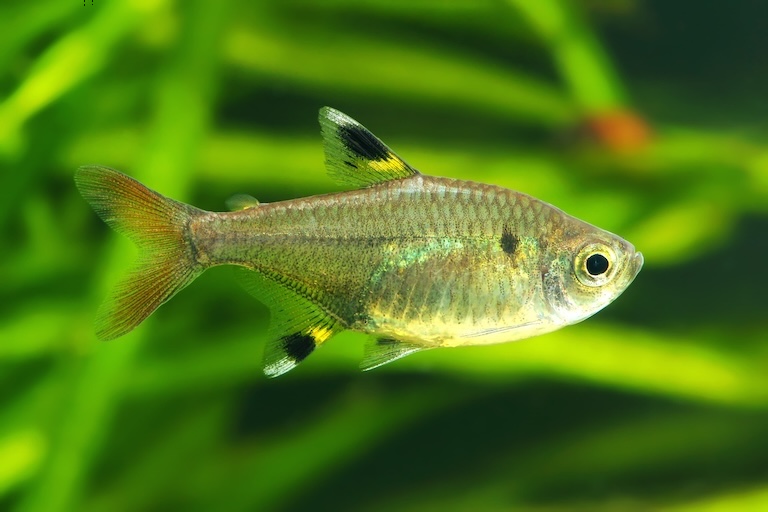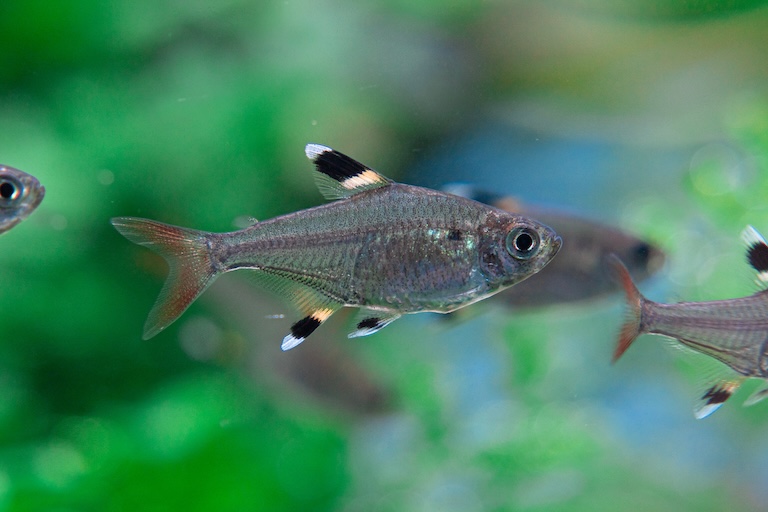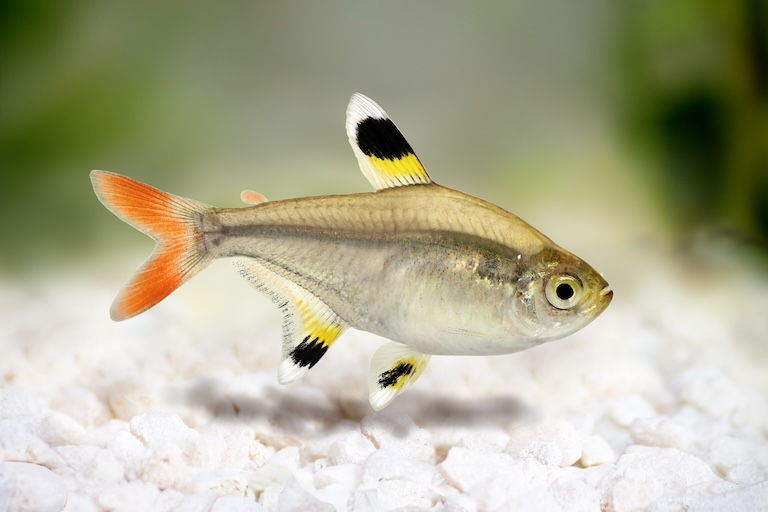X-Ray Tetra Profile
The slow-moving and crystal-clear waters of the Orinoco freshwater systems are one of the most visually appealing habitats on the planet, and some of the most commonly replicated in home aquaria.
The dense aquatic vegetation provides shelter and an entire lifetime of habitat for pretty little fishes like the tetras, among which are some pretty hardy species, popular for the simplicity with which they can be kept and the personality they bring to the table.
One of the most popular among them is an animal most reliably found on the X section of the A-Z: the X-ray Tetra.

X-Ray Tetra Facts Overview
| Habitat: | Tropical freshwater |
| Location: | Northeast South America |
| Lifespan: | 4-5+ years |
| Size: | Up to 4 cm (1.6 in) |
| Weight: | Not reported |
| Colour: | Silvery, translucent in parts, with yellow and black fins |
| Diet: | Small animals |
| Predators: | Larger fish, turtles |
| Top Speed: | Not listed |
| No. of Species: | 1 |
| Conservation Status: | Least Concern |
X-ray tetras are very cute animals, once a relatively obscure species known from the swamps and lakes of South America, now extremely popular in freshwater hobbyist setups.
They have the looks, the personality, and the low-maintenance required for a beginner fish, and a great way to learn that our aquatic brethren are more than just ornaments in motion.
Interesting X-Ray Tetra Facts
1. Water goldfinch
This fish goes by a few other names that aren’t going to win many general knowledge quizzes for you. There’s the pristella tetra, after its genus name; the signal tetra, after its flag-like fin colouration; and the water goldfinch, which is a bit of a baffling nickname and apparently because the goldfinch also has black and yellow in it.
But X-ray fish or X-ray tetra is more common, and this refers to its translucent top half, through which you can sometimes see its spine. There’s also the albino version, which is an artificially-selected morph that’s almost entirely see-through, and has its organs on display, too.
Regardless of the variant, this little fish is a member of the Pristella genus of Characids, a group of New World freshwater fishes, most of which are just as tiny as this little guy and often as pretty, too.

2. They’re from the Orinoco basin
Originally, the X-ray tetra was known as a pretty little freshwater fish from the Orinoco basin in Brazil. It’s also said to be found in many other regions of South America, though this claim is met with some scepticism, because there are thought to be some other species there that look just like it!
What’s certain is that it’s native to both the Orinoco and the Amazon basins, where it spends its days flitting about in the crystal clear waters of the slower-moving systems, where plants are plentiful and it can hide well.
In this stunning mini-habitat, it’s an important predator of small crustaceans and the larvae of other fish, but it has become far more commonly known as a low-maintenance contribution to indoor tropical home aquaria. 1
3. They need stimulation and space
In these home aquaria, the X-ray tetra is happiest when it’s not super crowded. An 80-litre tank is really the bare minimum to allow for the animal to exhibit its natural behaviours.
Sadly, “they’re just fish” is still a pretty common approach towards the animals we throw together in our fish tanks, but in reality, all the fundamentals of zookeeping still apply. These include what’s known as enrichment: basically “stuff” for the fish to hide in, play with and explore; and enough similarity to their native habitats to prevent anxiety and stereotypies, which are essentially the behavioural expressions of stress that captive animals exhibit when they’re not looked after properly.
While it’s not a good idea to crowd the tank with other species, though, one of the essential conditions for a happy tetra is to have it bring its friends along. 2
4. They’re social
This species is considered gregarious, which is a posh way of saying it likes to associate with its own kind.
It’s a shoaling fish, and if kept alone, would suffer in many of the same ways human people do in solitary confinement.
Most sources recommend that at least 8 of these fish should be kept in the same tank, preferably 12 or more, and this ticks a lot of boxes in terms of both enrichment and the facilitation of natural behaviours.
Competition can arise within the shoal if the tank is too small, but in general, if they have plenty of space, they tend to get along well. There may be a little bit of chasing, but it’s rare that conflict goes as far as physical contact in this species.
And so, keeping a happy shoal of X-ray tetras can be a great way to get into fish in general. 3
5. Beautiful beginner fish
Keeping fish can be one of those things that’s either deeply rewarding or biblically disastrous. As alien as an aquatic habitat is to us, it can be a trivial matter to over-salt, under-salt, over-heat, drop the pH too much, raise the pH too much, introduce an unexpectedly murderous snail, or just forget to feed them entirely. And owners of aquaria are as close to gods as our gangly, mortal forms should ever be.
So, proceed with caution, but with the right care, freshwater fish can be pretty low-maintenance and fascinating company. Fish have distinct personalities, habits and plenty more depth than we’re really wired to comprehend, and the X-Ray Tetra is a great example of one that’s easy to get by with.
They are tolerant of other animals, can handle a range of water parameters, and they’re very pretty little things. Their small size is also a bonus for smaller tanks.
6. Their habitat is being reduced
The population of this species appear to be stable, which is great news. A lot of this comes from the fact that they are easily bred in captivity, so the pet trade puts little to no pressure on the wild populations.
But, like all freshwater species, their habitats are being reduced with the expansion of humans, and even more, the quality of the water itself is being threatened.
Still, this species is highly adaptable and hardy – again, this is what makes it such an easy fish to keep – and so, its abundance in the wild doesn’t appear to have suffered so much, yet.
Currently, it’s listed as of Least Concern by the IUCN, and this assessment is as recent as 2020. 4

X-Ray Tetra Fact-File Summary
Scientific Classification
| Kingdom: | Animalia |
| Phylum: | Chordata |
| Class: | Actinopterygii |
| Order: | Characiformes |
| Family: | Acestrorhamphidae |
| Genus: | Pristella |
| Species Name: | maxillaris |
Fact Sources & References
- (2020), “X-Ray Tetra”, IUCN Red List.
- Ulrey (1894), “x-ray tetra ”,Fishipedia.
- Ulrey (1894), “Pristella maxillaris”, Fishbase.
- (2020), “X-Ray Tetra”,IUCN Red List.
